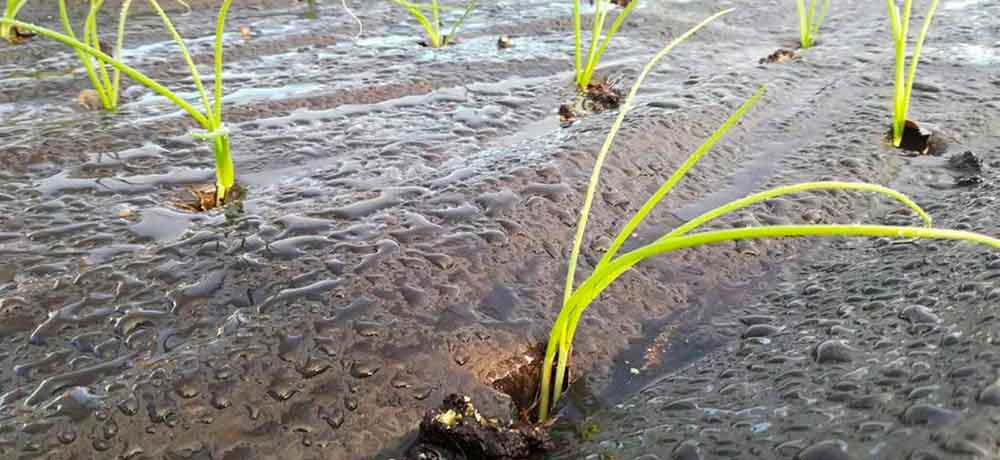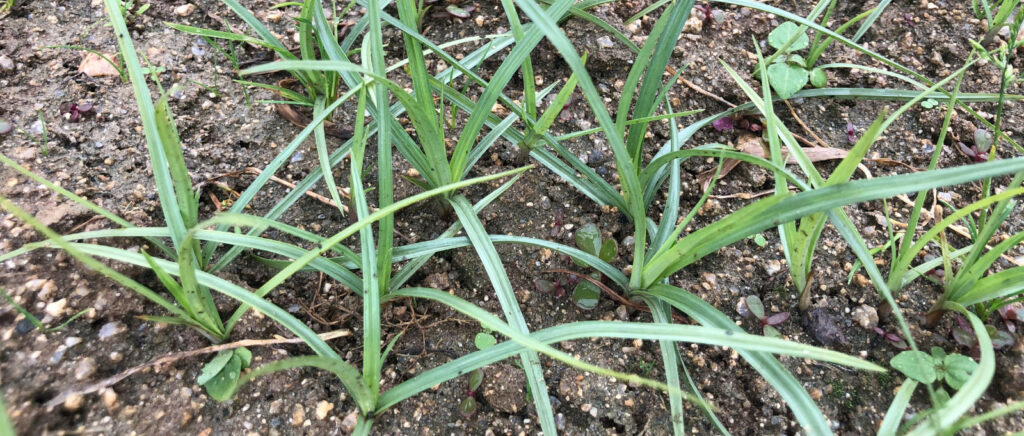Once again, welcome to our Novamulch agricultural space. On this occasion, we will conduct a detailed study on the water challenge in Spanish agriculture. Saving water in agriculture is one of the major challenges we face today and in the future, as this is one of the countries with a demand for approximately 80% of total national water resources, according to the Report on Water in Spain: Current Situation, Challenges, and Proposals (CEN, 2023), which we present in the following link:
https://www.rtve.es/noticias/20240217/agricultura-consume-80-agua-espana-sequias/15972242.shtml
Saving water in agriculture, whether in Spain or any other country, represents a necessity that requires us to create, without delay, short-term strategies to manage and implement smart irrigation technologies as well as well-planned and sustainable practices in all crop programs, so that we can guarantee the conservation of available aquifers and alleviate pressure on irrigation systems.
We are well aware that the consequences of climate change on our agricultural projects and our crops require us to intensify the vital requirements that guarantee optimal productivity and economic viability, and that is why we are bringing this important concern to our Novamulch agricultural space today.
Let’s make the most of every drop of water available. Let’s see how.
Water resources available by area in Spain.
Let’s now study water availability in countries like Spain, one of the countries with the highest crop variability and index in the EU. But first, let’s review the following link, which can provide some general information:
Let’s analyze the country by specific areas:
Demographic and aquifer characteristics of the areas with the greatest water availability.
North and humid areas.
Saving water in agriculture in northern Spain, especially on the Atlantic coast and in some mountainous areas such as the Cantabrian coast, the Pyrenees, and the northern slopes of the mountain range, does not warrant a wake-up call, as these regions enjoy higher rainfall, abundant watersheds, and therefore higher relative humidity than other areas of the country, as we will see shortly.
This area is characterized by high levels of annual precipitation, which results in frequent renewal of surface reserves and aquifers, as well as more abundant humid ecosystems that serve as regulators of overall water flow.
All of this makes intensive irrigation almost unnecessary, compared to other less favored areas.
Now, while it’s true that these optimal conditions of moisture availability, surface water, and groundwater generate good concentrations at certain times, they also cause runoff and flooding, loss of usable water, and diffuse pollution from the carryover of fertilizers or pesticides, which generally contaminate rivers and aquifers.
On the other hand, they generally result in periods of summer scarcity due to fluctuations in climate change, pressure from agricultural and industrial demand, or changes in land use, all of which easily affect the quality and effective availability of usable water.
Effective and sustainable methods for saving water in agriculture: Northern Spain.
We recommend several measures that can be very useful for saving water in agriculture, not only in the northern regions of Spain but throughout the country, as these are beneficial solutions. Let’s study.
Create a pre-plant plan that we have designed to structure drip or micro-sprinkler irrigation specifically targeted at the root system, thus reducing losses due to evaporation or runoff.
Conduct periodic soil moisture monitoring; even better if we implement the biodegradable paper mulch for this purpose, as it is a truly effective solution. Once installed, this material controls moisture levels during climatic fluctuations in our growing areas, and throughout all phases of development and evolution.
It is important to consider preparing and leveling the land beforehand, especially if it is uneven or sloping, to avoid runoff, leaching, and therefore the loss of both water and essential nutrients.
If we spread Novamulch biodegradable paper mulch and make holes to place seeds or seedlings, we will avoid all these risks that will ultimately harm the expected results, in terms of costs and production.
Likewise, the channels we create for controlled management of water transport throughout our area must be adequately lined to reduce potential leaks and uncontrolled losses.
Demographic and aquifer characteristics of areas of moderate water stress.
Ebro Plateau and Valley.
The Spanish Central Plateau is characterized by low winter temperatures and hot summers. Precipitation is concentrated in spring and autumn, while summers are dry with scarce and irregular rainfall. Therefore, saving water in agriculture in these areas is imperative during the summer months, when prolonged periods without rain occur, which compromises adequate moisture levels for crops.
Likewise, the Ebro basin experiences a water deficit during the summer and autumn months. Irrigated agriculture is intensive, and this is when irrigation demand is high. This is the time of year when vegetables, fruit trees, vines, rice, and other crops that require frequent irrigation are grown, when rainfall is scarce. Therefore, saving water in agriculture in this region must be planned in advance. River flows in the southern Aragón region decrease in the middle and lower reaches, necessitating water optimization, and snow reserves are increasingly unstable.
The Ebro basin has a network of reservoirs that regulates flow throughout the year, partially offsetting summer deficits. According to recent reports, the reservoirs are quite full (between 60% and 90% of their capacity), which helps mitigate water stress, but does not solve it. You can review the link below:
Effective and sustainable methods for saving water in agriculture: The Central Plateau and the Ebro Valley in Spain.
These areas are two of the most productive in Spain and experience moderate water stress due to their dry summers, irregular rainfall, and high water demand for irrigated crops, which forces most farmers to implement increasingly efficient water management techniques.
Let’s look at this link to a report from the Ministry of Agriculture. It explains that more than 80% of Spain’s water is used for irrigation, especially localized drip and micro-sprinkler irrigation, making the sector key to saving water in the region’s agriculture and promoting national water sustainability:
https://www.mapa.gob.es/es/desarrollo-rural/temas/gestion-sostenible-regadios
On the Meseta, vineyards, cereals, and other extensive crops predominate, and the irrigation system has recently been modernized, as seen in the following information we share:
As the meltwater supply to the Ebro River is decreasing due to climate change, all the focus is on selecting drought-resistant varieties and rootstocks, in addition to implementing rotations at the end of each crop. In these cases, the biodegradable paper mulch, Novamulch, plays an essential role. By naturally degrading at the end of each planting phase, it not only helps save water in agriculture but also integrates into the soil as an essential nutrient, promoting quality and sustainability for our future projects.
It’s highly recommended that, once the Novamulch biodegradable paper mulch has degraded, we replace it for the next planting season. This way, the soil structure will improve in quality, and we’ll continually save water in agriculture in each region.
Novamulch’s biodegradable paper mulch reduces water evaporation, maintains moisture balance in the root zone throughout the growing process, and thus minimizes watering frequency. It also prevents the spread of invasive weeds like sedge, which compete for water and nutrients, and prevents direct contact between our fruits and the soil.
Remember that using biodegradable plastics will increase our costs because we’ll need to remove the waste and complete its industrial processing, while Novamulch paper does this naturally and becomes a rich fertilizer for our farmland.
And if we decide to use natural mulches, we’ll have to periodically replace this material due to its rapid decomposition, and we run the risk of unwanted pests and diseases invading it. This will hamper the viability of our agricultural roadmap, and our plan to save water in agriculture won’t be as efficient.
On the other hand, the use of reclaimed and desalinated water to save water in agriculture is gradually being incorporated in areas with greater water stress, although its use is still low in Spain. These initiatives must be promoted in the short term and we must focus on all sustainable processes.
Demographic and aquifer characteristics of high scarcity areas.
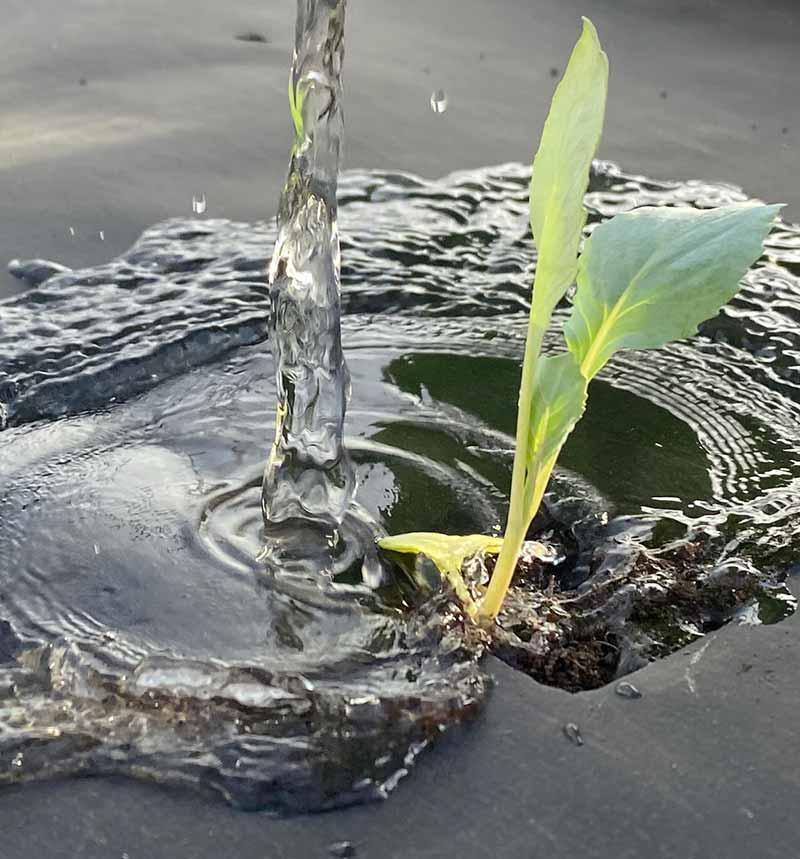
Comunidad Valenciana (Castellón, Valencia y Alicante), Región de Murcia y Provincia de Almería (Andalucía oriental), Islas Canarias.
First, let’s analyze this information that we share below:
https://soloriego.com/contenido/1232/como-prosperar-en-medio-de-la-escasez-de-agua
Let’s start with the regions of Murcia and the Valencian Community.
These regions are home to a significant agricultural population with a high density of irrigated farms. Let’s review.
In Murcia, economic activity depends almost entirely on intensive irrigation, horticulture, warm-climate fruit trees, and high-water-demand crops. Under these conditions, saving water in the region’s agriculture is a cause for concern. The following link is a small sample of the projected losses for the area:
The Canary Islands are different, as their high proportion of foreign population is concentrated in tourism sectors, as well as agricultural and residential areas, all of which put pressure on the availability of limited resources, especially water, which comes from underground.
Apparently, programs are being implemented for desalination, reuse of treated wastewater, loss management, policies limiting irrigation use, and incentives for irrigation modernization. Let’s hope everything goes well.
On the other hand, several communities face the demographic challenge of a growing older adult population, which affects the continued and necessary agricultural work, even though the younger population residing in some areas due to agricultural labor immigration could somewhat mitigate this situation.
Regarding the characteristics of aquifers and water availability in Murcia and Levante, we see that a large part of the agricultural supply comes from underground aquifers. Recent restrictions have led to cuts in these extractions, which shows that many aquifers are overexploited. In this link, we can review information on the treatment being implemented for water use in this area. Let’s take a look.
https://www.gobiernodecanarias.org/aguas/
Reservoirs and water infrastructure.
These regions have reservoirs that are expected to mitigate irregular and insufficient rainfall. However, most of these reservoirs have capacities that are susceptible to drought during the dry summer periods. Let’s listen:
https://rtvc.es/embalses-sequia-reservas-agua-gran-canaria-8-agosto-2025/
Effective and sustainable methods for saving water in agriculture: Levante, Murcia, eastern Andalusia, Canary Islands.
As we have reviewed, the regions of the Spanish Levant, Murcia, eastern Andalusia, and the Canary Islands are among the most water-stressed areas in Spain due to their semi-arid climate, very dry summers, and scarce and irregular rainfall. In these areas, the challenge for agriculture is to maintain productivity by minimizing water consumption without compromising crop quality.
We have found that modernizing irrigation systems has been essential in these areas. In the Region of Murcia, a pioneer in intensively irrigated agriculture, more than 85% of the irrigated area uses drip irrigation, allowing for extremely efficient water use. This link provides an interesting overview of activities related to this topic:
Now, under these critical conditions, which, although it is true, are being taken into consideration to prevent greater evils, it is necessary that we delve into what is the Novamulch biodegradable paper mulch as an indispensable agent and strategic ally to balance the overall and optimal structure and development of all crops under adverse conditions such as insufficient irrigation and prolonged drought.
In our Novamulch agricultural space, we’ve developed a special article about our biodegradable paper mulch, and we invite you to follow us at the following link, hoping we can be an effective and sustainable solution:
Acolchado agrícola. Beneficios, tipos y la alternativa biodegradable Novamulch.
You can purchase Novamulch biodegradable paper mulch below:
-
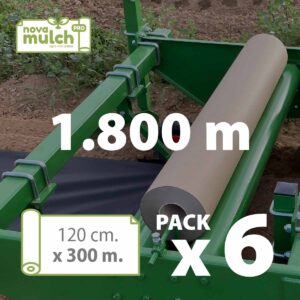 PACK of 6 rolls of Novamulch Professional paper 120 cm. x 300 m. (1.800 m)565,28 € IVA incluido
PACK of 6 rolls of Novamulch Professional paper 120 cm. x 300 m. (1.800 m)565,28 € IVA incluido -
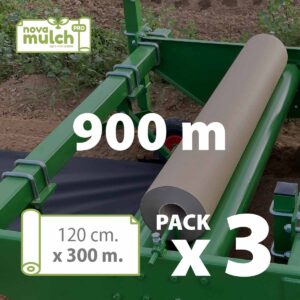 PACK of 3 rolls of Novamulch Professional paper 120 cm. x 300 m. (900 m)282,22 € IVA incluido
PACK of 3 rolls of Novamulch Professional paper 120 cm. x 300 m. (900 m)282,22 € IVA incluido -
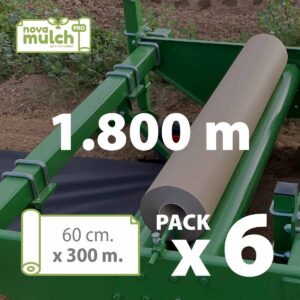 PACK of 6 rolls of Novamulch Professional paper 60 cm. x 300 m. (1.800 m)282,22 € IVA incluido
PACK of 6 rolls of Novamulch Professional paper 60 cm. x 300 m. (1.800 m)282,22 € IVA incluido -
 PACK of 3 rolls of Novamulch Professional paper 60 cm. x 300 m. (900 m)141,30 € IVA incluido
PACK of 3 rolls of Novamulch Professional paper 60 cm. x 300 m. (900 m)141,30 € IVA incluido -
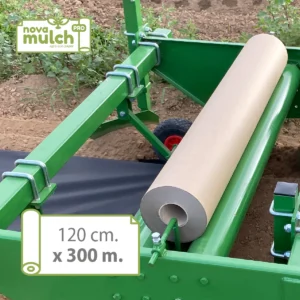 Novamulch Professional Paper 120 cm. x 300 m.94,21 € IVA incluido
Novamulch Professional Paper 120 cm. x 300 m.94,21 € IVA incluido -
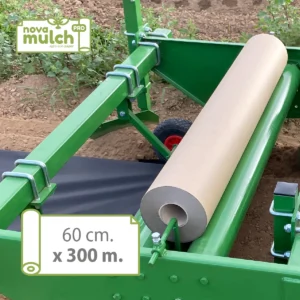 Novamulch Professional Paper 60 cm. x 300 m.47,10 € IVA incluido
Novamulch Professional Paper 60 cm. x 300 m.47,10 € IVA incluido -
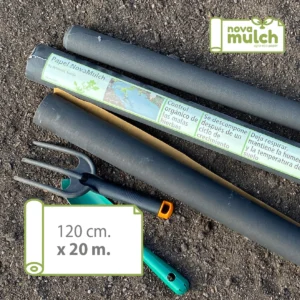 Novamulch paper 120 cm. x 20 m.41,63 € IVA incluido
Novamulch paper 120 cm. x 20 m.41,63 € IVA incluido -
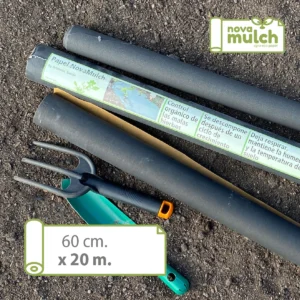 Novamulch paper 60 cm. x 20 m.21,89 € IVA incluido
Novamulch paper 60 cm. x 20 m.21,89 € IVA incluido -
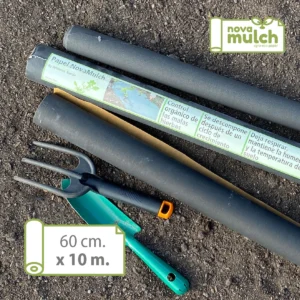 Novamulch paper 60 cm. x 10m.14,85 € IVA incluido
Novamulch paper 60 cm. x 10m.14,85 € IVA incluido -
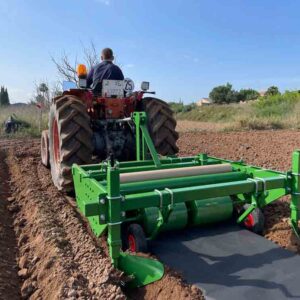 Novamulch agricultural mulching machine
Novamulch agricultural mulching machine
Conclusions and Final Reflections.
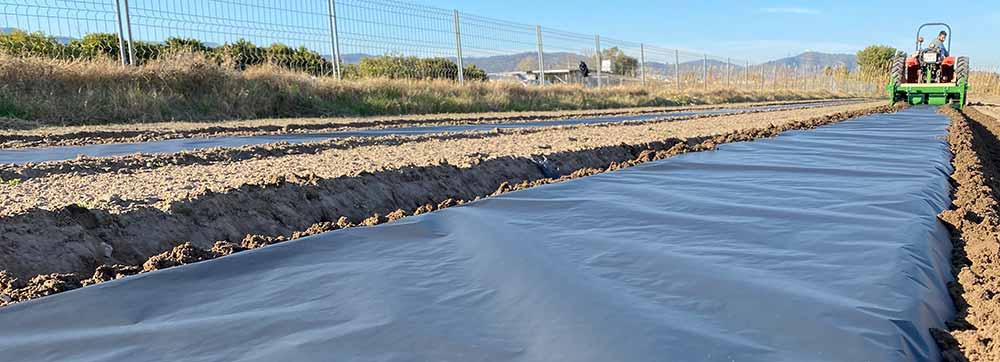
We know well that water is one of our biggest headaches. Those of us who address this thorny issue try to take steps every day to save water in agriculture and in the rest of our daily activities, regardless of the region in which we have designed our agricultural roadmap and our domestic lives.
Saving water in agriculture specifically requires us to implement strategies and plans to sustain and successfully grow all our crops and the environment we have available to grow them, whether on large commercial plots or in smaller spaces such as home and urban gardens, greenhouses, terraces, balconies, and flower pots.
We also select varieties that are resistant to pests and diseases, as well as those that adapt easily to unfavorable soils and insufficient water availability. Novamulch biodegradable paper mulch plays a vital role here.
We plan and regulate periodic drip or micro-sprinkler irrigation, combine fertigation to save water compared to regular maintenance, and implement the use of our biodegradable paper mulch, Novamulch, to control all eventualities of thermal, climatic, and water fluctuations, compaction, and fleeting and unforeseen evaporation.
We also compile a timeline for both fertilization and the control log for harvesting and safe storage, and in each of these phases, the key phrase we follow daily is saving water in agriculture.
Sustainable solutions such as reusing water, desalinating it, treating wastewater, leveraging the benefits of Novamulch biodegradable paper mulch in any environment, reducing the use of chemicals or plastics to improve the quality and structure of the soil and making it increasingly harmonious with its natural micronutrients and the environment, minimize the impact on our production costs and the results of our agricultural purpose.

